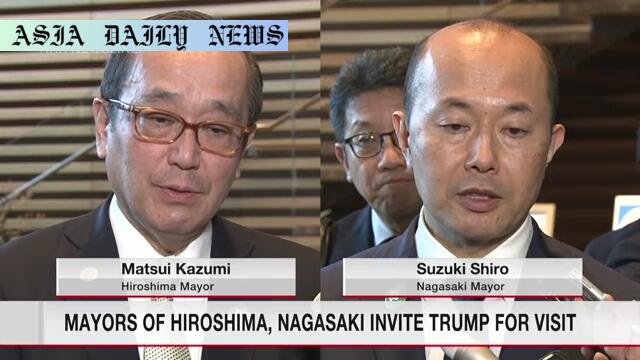Hiroshima mayors request Trump to visit the atomic-bombed cities to deepen his understanding of the bombings and promote global peace.
Hiroshima and Nagasaki mayors visited the US Embassy in Tokyo.
They requested that President Trump visit their cities for peace advocacy.
The visit coincides with the 80th year since World War II’s conclusion.
Embassy official Monahan pledged to convey the mayors’ request.

Hiroshima and Nagasaki: A Call for Global Leadership
This week, the mayors of Hiroshima and Nagasaki made a profound appeal during their visit to the US Embassy in Tokyo. Mayor Matsui Kazumi of Hiroshima and Mayor Suzuki Shiro of Nagasaki met with Katherine Monahan, the Charge d’Affaires ad interim, to request that US President Donald Trump visit their cities. Their primary goal was to encourage global understanding of the devastating impact of the atomic bombings and advocate for a world without nuclear weapons.
The Historical Significance of the Appeal
2023 marks a significant milestone: 80 years since the end of World War II. For the cities of Hiroshima and Nagasaki, this anniversary brings renewed urgency to reflect on the past and push forward with initiatives aimed at eradicating nuclear weapons. Both cities symbolize the catastrophic consequences of atomic warfare, and their leaders seek to channel this painful history into a global movement for peace. By advocating for Trump’s visit, the mayors hope to foster deeper international cooperation and leadership to achieve their vision of a nuclear-free world.
President Trump’s Role in Promoting Nuclear Peace
The mayors’ request comes at a time when geopolitical tensions surrounding nuclear weapons remain high. Hiroshima and Nagasaki see President Trump’s potential visit as an opportunity to bridge divides on this issue. By walking through the same streets that witnessed unimaginable devastation decades ago, the US president could gain firsthand insight into the human cost of nuclear conflict, inspiring decisive action for disarmament on a global scale.
Katherine Monahan’s Response and Future Implications
In response to the mayors’ appeal, Katherine Monahan expressed that their vision aligns with humanity’s collective future. She acknowledged the significance of marking this historic year with meaningful action. Monahan underscored the importance of the bond between the people of Hiroshima, Nagasaki, and the global community in pursuing a nuclear-free future. She further promised to relay the community’s request directly to President Trump, signaling the possibility of a significant diplomatic moment.
The Global Relevance of Hiroshima’s Advocacy
Hiroshima and Nagasaki, as cities that bear the scars of war, seek not only symbolic gestures but also actionable steps. Their advocacy resonates worldwide, particularly at a time when discussions about nuclear disarmament and peace require renewed attention. Their call for the US’s involvement demonstrates the power of grassroots leadership in driving global awareness and accountability.
A Hopeful Outlook for a Peaceful Future
As Hiroshima and Nagasaki commemorate the 80th year since World War II’s end, their leaders’ call for a significant US presence carries profound implications for the global peace movement. A presidential visit would not only emphasize the importance of remembering past atrocities but also underline the urgency of preventing them from recurring. This initiative sends a powerful message of hope and determination to achieve a shared goal of a nuclear-free world.



Commentary
The Courage of Hiroshima and Nagasaki’s Leaders
The mayors of Hiroshima and Nagasaki’s recent visit to the US Embassy in Tokyo is an inspiring example of local leadership with global implications. By stepping forward to address world leaders directly, they embody the resilience of their cities and highlight the urgent need for action on nuclear disarmament. Their advocacy seeks to ensure that the lessons of Hiroshima and Nagasaki remain at the forefront of international discourse.
The Importance of a Presidential Visit
A visit to Hiroshima and Nagasaki by the US president would be a monumental step toward reinforcing international commitment to ending nuclear arms. Such a visit could personalize the issue for world leaders and bring renewed focus to global disarmament efforts. Symbolic gestures often serve as catalysts for larger movements, making this visit an opportunity to re-energize the peace movement at a critical time.
A Call to Action for a Nuclear-Free World
Hiroshima and Nagasaki’s appeal is more than just a plea for remembrance—it is a call to action. As citizens of the world, we must rise above political divides to address the existential threat posed by nuclear weapons. The leadership shown by these two cities demonstrates the power of local voices in steering humanity toward a peaceful future. Let us hope their efforts inspire leaders to take bold steps for a safer, nuclear-free world.